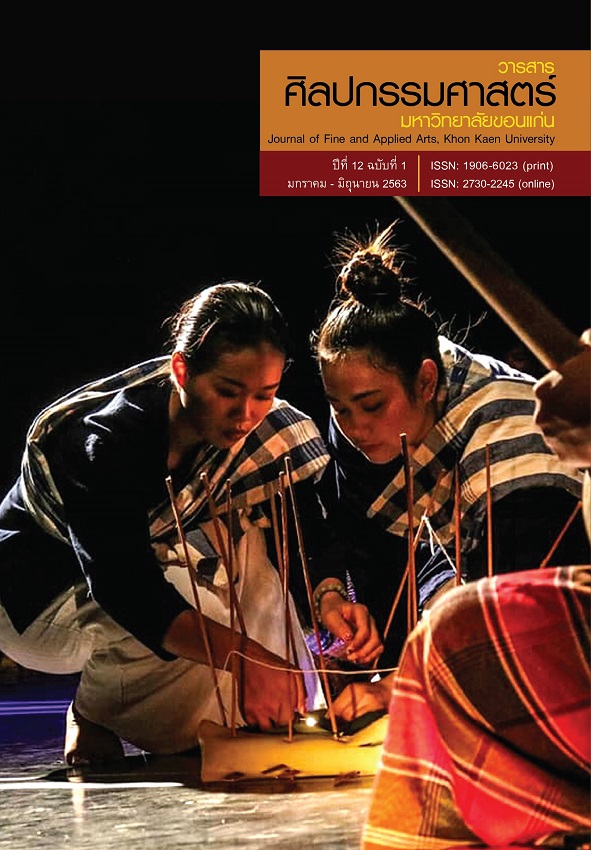Fabric Patterned Design Based on Tai Phuan and Tai Yuan Jok Weaving Art and Wisdom in Line with Creative Economy
Main Article Content
Abstract
Tai Phuan and Tai Yuan are ethnic groups with multiple dimensions of outstanding cultural identity including culture, custom and tradition, and food. Prominently signifying their ethnic identity among others is Pha Zin Teen Jok as art and wisdom accumulated and passed on from generation to generation. Generating value added from this cultural capital needs to embed ethnic identity in pattern design of Teen Jog that well reflects these ethnic groups. The purpose of this research was twofold: 1) to investigate Pha Jok art and wisdom of pattern design on Pha Zin of Tai Phuan and Tai Yuan in a case study of Sukhothai and Utaradit provinces; and 2) to design fabric pattern applying Teen Jok pattern on Pha Zin of Tai Phuan and Tai Yuan in line with creative economy. Research instruments consisted of structured in-depth interview form, sound record form, camera, fabric pattern scanner, notebook and pen, and triangulation. Research methodology involved 2 phases. Phase 1 explored the data of ethnic groups, Pha Jok art and wisdom of Tai Phuan and Tai Yuan in a case study of Sukhothai and Utaradit provinces Yuan in line with creative economy and design thinking theory. Phase 2 designed fabric pattern to apply to outfits and accessories using the capital of Pha Jok art and wisdom of pattern on Pha Zin of Tai Phuan and Tai Yuan in line with creative economy with design thinking process. Summary results are as follows. 1. In overall, fabric patterns of both ethnic groups showed their own distinctive identity while some patterns shared similarity as found in Lai Nok Khum (Tai Phuan) or Lai Nok Oum (Tai Yuan), Lai Sroy Sa, for example. Some had the same names and others had similar patterns but in different names. Their weaving instruments were mostly similar but in different names. 2. For the basis of Jok on fabric, the pattern was put at the top in Thai Phuan style and at the bottom in Tai Yuan style. 3. For color structure, both ethnic groups used red color for the foot of Pha Zin, and black, yellow, and green are major colors in traditional design. Today, Jok colors change on consumers’ preferences. 4.For main and supplementary patterns, 9 main and 11 supplementary patterns were found for Tai Phuan and 18 main and 37 supplementary patterns for Tai Yuan. 5. Two fabric patterns were designed including Lai Khum Burong Long Lai Sib Song produced by combining Lai Nok Khum and Lai Sib Song Nuay Tad as a design for Tai Phuan; and Lai Hong Liab Kai produced by combining Lai Pra Jum Yarm and Lai Hong Yai as a design for Tai Yuan. Yok Khao weaving process was employed with the use of threads in 3 colors i.e. red, green, and yellow. The finished patterns contained positive ideology. Creative economy approach adopted here in this research was to generate value added to the patterns of Teen Jok on Pha Zin by creating stories of ideology with less time to produce but preserving the preciousness of Pha Jok art and wisdom.
Article Details
Content and information in articles published in the Journal of Fine and Applied Arts of Khon Kaen University is regarded as the opinion and sole responsibility of the author(s) directly; therefore, editors are not obliged to agree to or share any responsibility with regard to the content and information that appears within these articles.
All articles, information, content, image, etc. that have been published in the Journal of Fine and Applied Arts of Khon Kaen University is the copyright of the Journal of Fine and Appllied Arts of Khon Kaen University. Any person or organization who wishes to distribute all or parts of the articles for further dissemination or other usage must first receive permission from the Journal of Fine and Applied Arts of Khon Kaen University before proceeding to do so.
References
กระทรวงพัฒนาสังคมและความมั่นคงของมนุษย์. (2558). บทนำ. แผนแม่บทการพัฒนากลุ่มชาติพันธุ์ในประเทศไทย (พ.ศ. 2558-2560). ค้นเมื่อ14 ตุลาคม 2559, จาก http://www.chatipan.dsdw.go.th/ pdf/F001.pdf
กระทรวงวัฒนธรรม. (2559). กระทรวงวัฒนธรรมขานรับนโยบายประเทศไทย 4.0 จัดประชุมสัมมนาติวเข้มขับเคลื่อนงานด้านมิติวัฒนธรรม. ค้นเมื่อ 13 กรกฎาคม 2560, จาก http://www.m-culture.go.th/th/ewt_news.php?nid=5665
ปิยะพร กัญชนะ. (2557). บันทึกจับผ้า เส้นใยแห่งไมตรีคนอาเซียนลุ่มน้ำโขง. กรุงเทพฯ: สถาพรบุ๊คส์.
มหาวิทยาลัยศิลปากร. (2543). ลวดลายและสีสันบนผ้าทอพื้นเมืองโครงการพัฒนาผ้าและผลิตภัณฑ์ผ้าพื้นเมืองทั่วประเทศเพื่อส่งเสริมการผลิตและการส่งออก. กรุงเทพมหานคร: มหาวิทยาลัยศิลปากร.
ศูนย์ส่งเสริมศิลปาชีพระหว่างประเทศ (องค์การมหาชน). (2553). ผ้าไทยมรดกแห่งภูมิปัญญาของไทย. กรุงเทพฯ: เอ.พี. กราฟฟิคดีไซน์และการพิมพ์.
สมิง จงกะสิกิจ. (2553). คนไทยเชื้อสายลาว. วารสารรักษ์วัฒนธรรมกลุ่มชาติพันธุ์, 1(2), 9-14.
สำนักงานเสริมสร้างเอกลักษณ์ของชาติ. (2558). ประมวลพระราโชวาทและพระราชดำรัสสมเด็จพระนางเจ้าสิริกิติ์พระบรมราชินีนาถ. กรุงเทพฯ: อมรินทร์พริ้นติ้งแอนด์พับลิชซิ่ง.
อรศิริ ปาณินท์. (2553-2554). การเปลี่ยนถ่ายสัมภาระทางวัฒนธรรมของชาวพวน:จากเชียงขวางสู่ลุ่มน้ำภาคกลางของไทย. วารสารหน้าจั่ว: ว่าด้วยสถาปัตยกรรม การออกแบบ และสภาพแวดล้อม, 7, 133.


